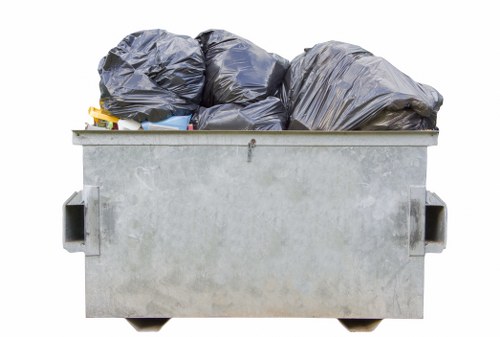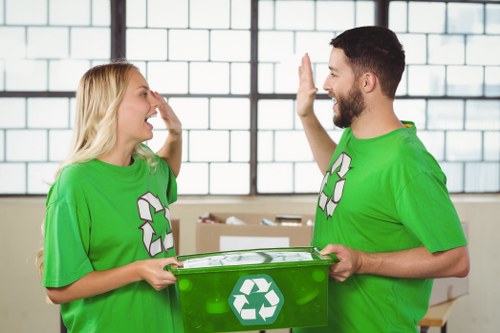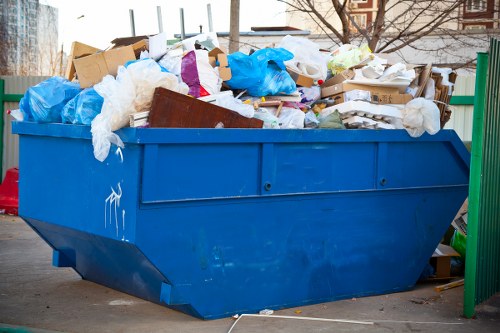Construction Waste Clearance in Brompton

Effective construction waste clearance is a critical component of any successful building project in Brompton. Whether you're renovating your home or managing a large-scale construction site, ensuring that waste is properly removed and disposed of is essential for maintaining a safe and efficient work environment.
Managing construction waste not only helps in keeping the site orderly but also plays a significant role in environmental sustainability. By implementing proper waste clearance strategies, builders and contractors can minimize their ecological footprint, comply with local regulations, and promote recycling and reuse of materials.
In Brompton, the demand for reliable waste clearance services has grown alongside the booming construction industry. Homeowners, developers, and contractors alike seek dependable solutions to handle the diverse types of waste generated during construction activities.

Why Proper Construction Waste Clearance Matters
Proper construction waste clearance is vital for several reasons:
- Environmental Protection: Proper disposal and recycling reduce the impact on the environment.
- Regulatory Compliance: Adhering to local waste management laws avoids legal penalties.
- Safety: A clean site minimizes accidents and hazards for workers.
- Cost Efficiency: Efficient waste management can reduce overall project costs.
Neglecting waste clearance can lead to environmental degradation, increased costs, and potential health risks, making it imperative for construction projects in Brompton to prioritize waste management.
Additionally, responsible waste clearance enhances the reputation of construction firms, showcasing their commitment to sustainability and community well-being.

Types of Construction Waste
Understanding the different types of construction waste is the first step in effective waste clearance:
- Concrete and Masonry: These materials are commonly generated from demolition and construction activities.
- Wood: Offcuts and scrap from framing and carpentry work.
- Metals: Includes steel, aluminum, and other recyclable metals.
- Drywall: Waste generated from the installation and removal of drywall.
- Plastics: Various plastic materials used in construction processes.
- Hazardous Materials: Includes asbestos, lead, and other dangerous substances that require special handling.
Each type of waste requires specific handling and disposal methods to ensure compliance and environmental protection.

Steps for Effective Waste Clearance
Implementing a structured approach to waste clearance ensures efficiency and compliance:
1. Assessment and Planning
Start by assessing the project site to identify the types and quantities of waste expected. Developing a waste management plan helps in organizing disposal methods and schedules.
2. Segregation of Waste
Separating different types of waste at the source facilitates recycling and proper disposal. For example, metals and wood should be kept separate from general debris.
3. Recycling and Reuse
Recycling materials like metals, concrete, and wood can significantly reduce the volume of waste sent to landfills. Reusing materials when possible also contributes to sustainability efforts.
4. Safe Disposal
Hazardous waste must be handled according to strict regulations. Partnering with certified waste disposal companies ensures that dangerous materials are managed safely.
5. Continuous Monitoring
Regularly monitoring waste management practices helps in maintaining efficiency and making necessary adjustments throughout the project lifecycle.

Choosing the Right Waste Clearance Service in Brompton
Selecting a reliable construction waste clearance service is crucial for the success of your project. Here are key factors to consider:
Experience and Expertise
Opt for companies with a proven track record in handling construction waste. Experienced service providers understand local regulations and have the necessary equipment to manage various waste types.
Compliance and Certifications
Ensure that the service provider complies with all local and national waste management laws. Certifications indicate adherence to industry standards and best practices.
Comprehensive Services
Choose a company that offers a full range of waste management services, including collection, transportation, recycling, and disposal. Comprehensive services simplify the process and ensure consistency.
Environmental Responsibility
Partner with environmentally conscious companies that prioritize recycling and sustainable practices. This not only benefits the planet but also enhances your project’s green credentials.
Cost-Effectiveness
While cost is an important factor, it should not compromise the quality of service. Compare quotes and services to find a balance between affordability and reliability.

Benefits of Professional Waste Clearance
Hiring professional waste clearance services offers numerous advantages:
- Efficiency: Professionals have the tools and expertise to manage waste swiftly and effectively.
- Safety: Reduces the risk of accidents by handling hazardous materials properly.
- Space Management: Frees up valuable space at the construction site, improving workflow.
- Regulatory Compliance: Ensures that all waste is disposed of in accordance with laws, avoiding legal issues.
- Environmental Impact: Promotes recycling and reduces landfill use, benefiting the environment.
By leveraging professional services, construction projects in Brompton can maintain high standards of safety, efficiency, and environmental responsibility.
Moreover, professionals can provide customized waste management solutions tailored to the specific needs of your project.

Environmental Considerations in Waste Clearance
Environmental sustainability is a key aspect of modern construction practices. Effective waste clearance contributes significantly to these efforts:
Recycling Initiatives
Implementing robust recycling programs helps in diverting substantial amounts of waste from landfills. Materials like metals, wood, and concrete can be repurposed, reducing the need for new resources.
Minimizing Landfill Use
By reducing the volume of waste sent to landfills, construction projects can lower their environmental impact. Strategies include optimizing material usage and enhancing recycling rates.
Reducing Carbon Footprint
Efficient waste management practices can significantly cut down the carbon emissions associated with transportation and disposal of waste.
Promoting Sustainable Practices
Encouraging the use of sustainable materials and practices throughout the project lifecycle aligns with global sustainability goals.

Cost Factors in Waste Clearance
Several factors influence the cost of construction waste clearance in Brompton:
- Volume and Weight: Larger and heavier waste requires more resources to handle and transport.
- Type of Waste: Hazardous materials often incur higher disposal fees due to the specialized handling required.
- Frequency of Collection: Regular pickups may offer cost savings compared to infrequent, large-scale removals.
- Accessibility: Difficult-to-reach sites may require additional equipment or labor, increasing costs.
- Recycling and Disposal Fees: Rates vary based on the types of materials being recycled or disposed of.
Understanding these factors can help in budgeting and choosing a waste clearance service that offers the best value for your specific needs.
Additionally, investing in efficient waste management can lead to long-term cost savings by reducing potential fines and enhancing operational efficiency.

Regulatory Compliance for Waste Management
Construction projects in Brompton must adhere to various waste management regulations to ensure legal compliance and environmental protection:
Local Ordinances
Local governments may have specific rules regarding waste disposal, including permitted landfill sites and recycling requirements. It's essential to be aware of these regulations to avoid penalties.
National Standards
National environmental standards dictate the handling of different types of waste, especially hazardous materials. Compliance ensures that projects meet broader environmental goals.
Permits and Documentation
Obtaining the necessary permits for waste disposal and maintaining accurate documentation is crucial for regulatory compliance and accountability.
Inspections and Audits
Regular inspections and audits ensure that waste management practices meet the required standards. Preparing for these evaluations by maintaining organized records and practices is vital.
Penalties for Non-Compliance
Violating waste management laws can result in significant fines, legal action, and damage to a company's reputation. Ensuring compliance safeguards against these risks.

Innovative Waste Clearance Solutions
Advancements in waste management technology offer innovative solutions for construction waste clearance:
Automated Sorting Systems
Automated systems enhance the efficiency and accuracy of waste sorting, enabling better recycling rates and reducing manual labor.
On-Site Waste Processing
On-site processing facilities allow for immediate handling of waste, minimizing transportation costs and reducing the environmental impact.
Green Technologies
Utilizing eco-friendly technologies, such as solar-powered machinery and energy-efficient vehicles, contributes to sustainable waste management practices.
Digital Tracking Systems
Digital systems for tracking waste generation and disposal ensure transparency and improve the overall management process.
Smart Waste Management
Integrating smart technologies, such as IoT sensors, can optimize waste collection schedules and enhance operational efficiency.

Challenges in Construction Waste Clearance
Despite the benefits, several challenges can impact effective waste clearance in construction projects:
- Volume Management: Large-scale projects generate immense amounts of waste, requiring robust management strategies.
- Hazardous Materials: Handling hazardous waste demands specialized equipment and trained personnel.
- Logistical Constraints: Limited access to disposal sites or transportation issues can hinder timely waste removal.
- Cost Fluctuations: Variable disposal fees and recycling costs can complicate budgeting.
- Regulatory Changes: Staying updated with evolving regulations requires continuous effort and adaptation.
Addressing these challenges involves proactive planning, investment in the right resources, and collaboration with experienced waste management professionals.

Best Practices for Sustainable Waste Clearance
Implementing best practices ensures that waste clearance operations are both effective and sustainable:
Minimize Waste Generation
Designing projects with waste reduction in mind can significantly lower the volume of waste produced. Strategies include precise material estimation and efficient resource utilization.
Use of Recyclable Materials
Selecting materials that are easily recyclable enhances the sustainability of construction projects and reduces the burden on waste disposal systems.
Employee Training
Training workers on proper waste management techniques ensures that everyone on site contributes to effective waste clearance.
Regular Audits
Conducting regular waste audits helps in identifying areas for improvement and ensuring compliance with waste management plans.
Collaborate with Sustainable Partners
Partnering with eco-friendly waste clearance companies fosters a culture of sustainability and promotes responsible waste management practices.

The Future of Construction Waste Clearance in Brompton
The future of construction waste clearance in Brompton looks promising, with ongoing innovations and an increasing focus on sustainability:
Increased Automation
Automation will streamline waste management processes, making them more efficient and reducing the reliance on manual labor.
Enhanced Recycling Technologies
Advancements in recycling technologies will allow for a broader range of materials to be processed and reused, further minimizing landfill dependence.
Circular Economy Models
Adopting circular economy principles, where waste is treated as a resource, will drive more sustainable construction practices.
Policy Developments
Stricter environmental policies and incentives for sustainable practices will encourage more responsible waste management among construction firms.
Community Engagement
Engaging with local communities and stakeholders promotes transparency and fosters a shared responsibility towards environmental stewardship.
As the construction industry evolves, embracing these trends will ensure that construction waste clearance in Brompton remains efficient, compliant, and environmentally friendly.

Conclusion
Effective construction waste clearance in Brompton is essential for the success of any building project. By understanding the types of waste, implementing structured clearance processes, and partnering with reliable service providers, construction projects can achieve operational efficiency, regulatory compliance, and environmental sustainability.
Embracing best practices and innovative solutions will not only streamline waste management but also contribute to the broader goals of sustainability and community well-being. As the construction industry continues to grow in Brompton, prioritizing waste clearance will remain a cornerstone of responsible and successful project execution.
Contact us today to learn more about our professional construction waste clearance services and how we can support your next project in Brompton.